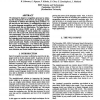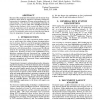93
Voted
NAACL
1994
15 years 2 months ago
1994
We attemped to improve recognition accuracy by reducing the inadequacies of the lexicon and language model. Specifically we address the following three problems: (1) the best size...
NAACL
1994
15 years 2 months ago
1994
We desert'be our latest attempt at adaptive language modeling. At the heart of our approachis a Maximum Entropy(ME) modelwhich inc.orlxnatesmanyknowledgesources in a consiste...
121
click to vote
NAACL
1994
15 years 2 months ago
1994
We have been developing a spoken language system to recognize and understand spontaneous speech. It is difficult for such systems to achieve good coverage of the lexicon and gramm...
NAACL
1994
15 years 2 months ago
1994
In this paper, we describe a reversibleletter-to-sound/soundto-letter generation system based on an approach which combines a rule-based formalism with data-driven techniques. We ...
139
Voted
NAACL
1994
15 years 2 months ago
1994
The BYBLOS continuous speech recognition system is applied to on-line cursive handwriting recognition. By exploiting similarities between on-line cursive handwriting and continuou...
109
Voted
NAACL
1994
15 years 2 months ago
1994
This session had five papers related to different topics in CSR Search. The topics ranged from integration of many knowledge sources within a practical system, to different search...
98
Voted
NAACL
1994
15 years 2 months ago
1994
Because of the complexity of documents and the variety of applications which must be supported, document understanding requires the integration of image understanding with text un...
123
Voted
NAACL
1994
15 years 2 months ago
1994
The goal of this study is to evaluate the potential for using large vocabulary continuous speech recognition as an engine for automatically classifying utterances according to the...
NAACL
1994
15 years 2 months ago
1994
Development has begun on a semantic evaluation (SemEval) methodology and infrastructure for the ARPA Spoken Language Program. SemEval is an attempt to define a task-independent te...
NAACL
1994
15 years 2 months ago
1994
Thispaperintroduces a simple mixtare languagemodelthat attempts to capture long distance conslraints in a sentence orparagraph. The model is an m-component mixture of Irigram mode...






